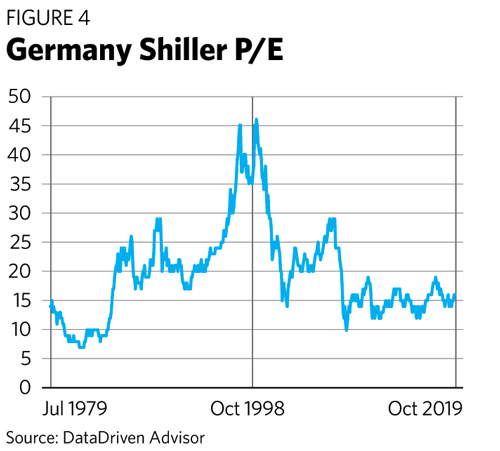Let’s start with international bonds. A large international bond fund, the SPDR Bloomberg Barclays International Treasury Bond ETF (BWX), has a 30-day SEC yield of 0.47%. A large emerging market bond fund, the VanEck Vectors J.P. Morgan EM Local Currency Bond ETF (EMLC), has a 30-day SEC yield of 4.45%. For international bonds in total we’ll make a rough assumption of 70% in developed and 30% in emerging markets. So we should expect a return of 0.70% x 0.47% + 0.30% x 4.45%, or 1.66%, on our international bonds.
While this is similar to our U.S. bond expectations, there is a diversification element provided by holding international currencies. If the U.S. dollar depreciates, these bonds might do well. Of course, the reverse holds true if the dollar strengthens.
 How about international stocks? Look at valuations for the four largest developed countries: Japan, Germany, the U.K. and France. For a visual, here is the Shiller P/E of Germany, the largest of the European countries (Figure 4).
How about international stocks? Look at valuations for the four largest developed countries: Japan, Germany, the U.K. and France. For a visual, here is the Shiller P/E of Germany, the largest of the European countries (Figure 4).
All of the largest developed international countries have valuations within a one-half standard deviation of their median (and all of them are below median), implying there will be a normal range of returns going forward. Over the last 50 years, developed international equities have averaged 9.33% annually, and with normal valuations this is our current expectation.
How about emerging markets? Here we will examine the valuations of the four largest emerging market countries—Brazil, Russia, India and China (the BRICs). Each has a valuation within a one-half deviation of its median (with three of the four countries seeing it fall below median). That implies there will be a normal range of returns going forward. Over the last 50 years, emerging market equities have averaged 12.02% annually. More conservatively, we’ll use the same 9.33% returns that developed international equities earned to set our expectations.
For international stocks in total, we’ll make a rough assumption of 70% in developed and 30% in emerging markets. In that case, we should expect a return of 9.33% (or 0.70% x 9.33% + 0.30% x 9.33%).
Now we get to the difficult stuff: real estate, gold and commodities.
Real estate is a bit troubling. We haven’t found any literature pointing to a framework to determine expected returns here (and if you know of any, please share). Looking at historical data, real estate investment trusts have averaged 8.90% over the last 50 years, and 8.18% since 2000. Taking a global approach and employing a reasonable amount of conservatism, let’s assume there is a return figure midway between our expectations for U.S. stocks (3.55%) and international stocks (9.33%). Thus, 6.44% seems like a reasonable expectation from REITs.
Gold and commodities are the most difficult to set expectations for, since they have no intrinsic value, earnings or dividends. Looking at the historical data, gold has averaged returns of 7.83% over the last 50 years, and 8.64% since 2000. Let’s take the lower of the two, 7.83%, for gold. Similarly, commodities have averaged 6.73% over the last 50 years, but have fallen 0.33% since 2000. To be conservative, let’s average the two periods and end with 3.20% as our outlook for commodities.
I define the diversified portfolio as equally weighting each asset class—U.S. stocks, U.S. bonds, international stocks, international bonds, real estate, gold and commodities. This is not how I recommend allocating a portfolio, but it is a reasonable way to discuss the features of diversification in general.
The expectation for a diversified portfolio would be one-seventh of each of the individual pieces:
(1/7)*4.32% + (1/7)*0.68% + (1/7)*1.66% + (1/7)*9.33% + (1/7)*6.44% + (1/7)*7.83% + (1/7)*3.20% = 4.78%.
As we did with the 70/30 portfolio, we add in the average diversification return: The median for a diversified portfolio over 10-year periods is 1.12% annually.
Taken together, our expectations for a diversified portfolio are 5.90%. This is almost 65% more than the expectation from a 70/30 portfolio alone. But don’t take my word for it. Plug in your own assumptions and position sizes.
We’ve rarely been faced with such low expectations on both U.S. equities and U.S. bonds at the same time. Today’s domestic investing market suggests that this is possibly the most important time in history for investors to be eschewing home bias and embracing a multi-asset-class, globally diversified portfolio. Let us be clear: The odds seem heavily stacked in the favor of diversification.
Randy Kurtz, CFP, is founder of the DataDriven Advisor, a registered investment advisory firm in Chicago. For more information, visit atadrivenadvisor.com.








